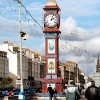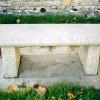Today he is virtually forgotten, yet he fathered no fewer than one hundred and ninety three short salon pieces and organ works. Information about his remarkable life is distinctly hard to obtain, yet he was a contemporary and associate of Thomas Hardy, and set many of the writer’s poems to music. Now, after more than a century, the obscure and remarkable persona of Frederick Boyton Smith has been partly rediscovered through exhaustive researches at the Dorset History Centre and lengthy behind-the-scenes correspondence with Ms Susan Bell, to whom the author of this biographical portrait would like to acknowledge thanks for all her helpful information about Frederick Boyton Smith and his brother Edward Sydney Smith.
Frederick W Boyton Smith was born in Dorchester in September or October 1837, and is recorded as having been baptised on October 13th in Dorchester’s St Peters Church. Frederick was clearly born into a musical family, for his father, also named Frederick William Smith, was a musician; his mother, Helen Boyton and her sister Clara (who was a teacher of music) were the daughters of Richard Boyton, a professor and teacher of piano. Helen was originally from Clifton, Bristol, where she married Boyton’s father in September 1835. To avoid confusion with his father, Frederick jr. is usually known as Boyton Smith. The 1861 census shows that Boyton Smith’s father was originally a Kentish man from Deal, had moved with Helen to Dorchester. He is recorded as being ‘a professor of music and dance.’
At the age of four, Boyton is recorded as living with his parents and brothers Sydney and Walter at Cornhill, Dorchester, but by 1851 the family had evidently moved to 16 South Street. However, the census that year does not include Boyton, as by this time he was studying the organ under George Townshend Smith at Hereford Cathedral, and instead is noted in that town’s census as visiting the home of one Mary Ann Watt on census day. It is thought that Boyton was probably a boarder at the Cathedral school rather than living in with Townshend Smith, but it is uncertain whether he received further training in the subsequent years. By the time of Dorchester’s 1861 census the Smiths had moved to 53 High West Street and Sydney Smith had left for Leipzig in 1855 to study piano, violin, cello, harmony, counterpoint and composition.
Boyton Smith, too, by 1861 had left Dorchester to live in with a spirit merchant’s widow called Ann Gare and her two daughters in Chard, Somerset. The connection seems to have been through Boyton, who by now was recognised as a professor of music, possibly working for the British National School where Mrs Gare was Mistress. One of her daughters, Janette, is recorded as being an assistant at the school, which was situated close to the Gare home in the High Street.
While Boyton and Sydney would have learnt music from their parents at an early age the former’s earliest known published piece was a transcription for piano of a two-part song by Mendelssohn called “Greetings” in 1861. The rest of the decade continued to be a productive and fruitful time for Boyton, during which time forty compositions were published. These were variable pieces suitable for the drawing room, many being for the piano, but also including arrangements based on operatic songs and melodies. There are also songs based on the poetry of Longfellow, Kingsley and Goethe and one piece of sacred music. Most of these works were published by Chappell & Co, Edwin Ashdown, Weeks & Co, or Novello. Of especially high value to Gilbert and Sullivan officionado’s is an arrangement of a lost song from a comic opera by Sullivan called “The Chieftain,” first performed at the Savoy Theatre in 1894.
Boyton appears to have had a penchant for giving his pieces titles in French such as “Sur le Lac Morceau de Salon pour Piano.” This reflects a trend for all things French at the time among upper class Victorian ladies and a good deal of published sheet music in the 1860’s either came from Paris or else purported to come from there.
Yet despite his prolific output in catering for the 19th century demand for drawing room pieces, Boyton Smith and his music are largely forgotten, and even in his home town his name is largely unrecognised and his achievements undocumented.
In 1864 Boyton Smith married a Clifton woman. Penelope Mary Ann Rawle, Penelope had been born in Clifton in 1842, but the 1861 census clearly shows that by then Boyton’s future wife was working as a governess at Burton, Winfrith Newburgh. The birth of a son, Sydney, was registered in Dorchester in 1865 showing that the family was living there by then. The Dorchester Holy Trinity Baptism Register notes that Sydney was followed by Florence (1867), Helen (1868) and Margaret Ada (1869.) The 1869 record gives Boyton’s occupation as organist (he was appointed Organist at Holy Trinity) and his address as Alexandra Terrace, Dorchester.
In February 1866 Boyton’s younger brother Walter, a bookseller by trade, died from nephritis aged only 25. By 1871 the family was living at 39 South Street, close to the home of Helen, Boyton’s mother, who had been widowed the previous year. The census shows that another son, Frederick, was added to the family only one month before and the presence of three servants show that by then Boyton Smith was well-to-do in his capacity as a professor of music. Indeed, the 70’s again saw the publication of another forty or so small compositions and works for the organ. These included sacred music such as “Lo! I will Give you Rest;” “Andante con Moto” (an organ piece) and arranged piano duets such as “The Flying Dutchman.”
However, most of the forty compositions of the 70’s hang on lightweight pieces for the parlour in the manner of “L’Echo du Tyrol” fantasy for piano, or “Jeanne de Arc,” a gallop de salon. “The Love Who’s All to ME” was a popular ballad, while “The Ash Grove” was a well known aire. Yet Boyton was also moved to write music designed to help beginners and students, seen in, for example, “The Pianists Daily Practice” and “The Russian National Hymn.”
But the 1870’s also spelt tragedy for Boyton Smith. The family had evidently moved to Melcombe Regis soon after the 1871 census day, for the Cemetery Chapel there records the burial, on January 2nd, 1872, of the infant Frederick at only 9 months and in January 1876 the burial of a later infant son, baptised Frederick Walter aged only ten weeks. The family’s address was then 2 Frederick Place, Melcombe, but by 1881 it was Lawn House in Lennox Street, where Boyton’s other daughters Helen and Ada also resided. Here another baby, Frances, was born in 1881.
During the years in Melcombe Boyton’s occupation is given as Music Teacher, where his pupils would have attended at Frederick Place. During the 1880’s Boyton was still composing and arranging, his tally for the decade being about another 45 pieces. The Boyton Smith’s with their daughter Helen were still living at Lawn House on census day 1891, their youngest daughter Frances by that time being a boarder at the same school in Wyke Regis that Helen had attended ten years earlier. It is possible that by this time too, Sydney, was studying for a BA in Durham, for the same ‘S Boyton Smith’ appears as President of the St. Cuthbert’s Society, on that city’s St. Cuthbert College’s register in 1895.
Though only 50 when he died in 1889 Edward Sydney had by the end of his life established himself as a prolific composer in his own right, searches having brought up details of four hundred and sixty-seven published compositions. We will publish a brief biographical piece about Sydney Smith shortly.
The end of the 19th century saw the publication of a great volume of sheet music for the middle class amateur to play at home. During this period Boyton Smith published his “Fantasia” based on four more Sullivan operas as well as other opera-based arrangements and waltzes. Yet a discernible shift in genre from parlour to sacred music is evident in Smith’s repertoire during the 1890’s. In all, seven pieces of church music for Novello’s Parish Choir Books and organ pieces such as his Grand March in D were published. The latter is still played occasionally as the recessional at church weddings, though its composer’s name has long since become disassociated with it.
Sometime before 1901 Boyton Smith had evidently moved back to Dorchester; for he is listed in that year’s census as living at 56 High West Street. Very near his parent’s former home at No. 53. He was then 64 years old, still a professor of music, though one ‘employed on his own account.’ Living with him was his wife Helen, her 84 year-old spinster aunt Mary Jane Rawle and one servant. The couple’s elder daughter Florence had become Mrs Edward Salisbury living in London with her husband, their four-year-old daughter, and sister Frances, then twenty years old. Florence and Edward had married in 1887 in a ceremony witnessed by both Sydney and Frederick Boyton Smith. Ada had married George Herbert Lock and was living with her husband, two daughters and sister Helen, then 32, in Shrewsbury. In 1893 Ada had published a composition of her own called “Romance for Violin and Piano” under the name of Ada Boyton Smith. Boyton Smith’s son Sydney went into the Church, becoming an Anglican clergyman who married an Irish woman from Enniskillen called Mary Cooney. By peculiar coincidence the 1901 census shows that Mary’s father William was living in Clifton with her and Sydney, so maintaining a Bristol connection within the family.
At the time when Boyton Smith embarked on his career as a composer, other European composers, whether of piano music or more ambitious works for orchestra, were much in vogue, while England was regarded as something of a musical backwater or desert, which not even the great Godsends and legacies of Elgar, Parry or Vaughn Williams could entirely dispel. The only way a young English composer could hope to gain recognition or financial reward was through the composition of pieces for gifted amateurs. Over the decades Boyton Smith recognised the opportunities that the growing popularity of British musical comedy presented. By the beginning of the 20th century this medium had established itself as the most successful school of operetta in Europe. But as the century progressed the nature and character of Smith’s repertoire changed. Music with commercial potential diminished in importance, a luxury of omission Smith perhaps felt he could afford now that his children were financially independent.
Between 1900 and 1919 Boyton published another twenty-eight pieces of music, half of these being sacred music for the Church. But during this period too, another highly important and ultimately world-renown figure was about to enter his life. He was not a composer or primarily anyone with a career in music; nor was he some distant nonentity from afar off, but a world-renown contemporary who had lived and worked in Boyton Smith’s own town and neighbourhood throughout both their lives. Two men who had made names for themselves in their own ways and had perhaps rubbed shoulders without getting to know the measure of each other.
So did Frederick William Boyton Smith join the throng of the many notables who were friends or associates of the great Thomas Hardy…
To be continued…
[Cut and paste or click on this link to hear Phillip Sear play Boyton Smith’s ‘Isle of Beauty.’ http://www.youtube.com/results?search_query=Phillip+Sear+Boyton+Smith&aq=f



